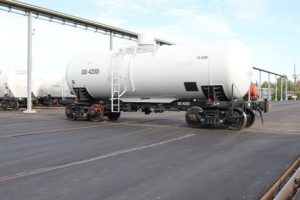 UWC will deliver EuroChem new tank cars under a contract which stipulates that they will be sent by the end of this year to Novomoskovskiy Azot, part of EuroChem Group. The new cars will be used for the transport of concentrated nitric acid.
UWC will deliver EuroChem new tank cars under a contract which stipulates that they will be sent by the end of this year to Novomoskovskiy Azot, part of EuroChem Group. The new cars will be used for the transport of concentrated nitric acid.
UWC says that this tank cars differ significantly from the currently standard models. With a loading capacity of 75 tonnes, the cars allow the consignor to increase loads by one third per car.
The car’s tank is made from AD0-grade aluminium, which has guaranteed physical characteristics and a performance rating 40% higher than the rolled stock used in standard models. The tank is manufactured using the friction stir welding technique, which has a number of advantages compared with fusion welding. This significantly reduces the likelihood of joint defects, minimizes harmful environmental impacts, and increases the joint’s strength and flexibility indicators by 10% compared to the original state of the material.
“Tank cars for transporting concentrated nitric acid are among the most technically advanced products in our company’s portfolio and in fact offer a unique transportation solution for today’s domestic market. The product represents the successful synergy between progressive thinking and modern production sites,” Boris Myagkov, Deputy CEO for Commerce and Marketing at UWC said.
The service life of this tank car model (15-6901 model) is 40 years, compared with 20 years for current mass market tank car models. The bogie has the significant advantage allowing for an increase in the maintenance interval up to 1 million km, or eight years. For comparison, standard models are sent for their first depot repair after running 210,000 km, or two years.
The tank and discharge system are airtight, the valve is equipped with a safety membrane, and the car uses a modern discharge valve lined with an acid-resistant polymer. This ensures that the freight is safely isolated from the tank car’s operating personnel and the environment. The possibility of installing a radar level sensor ensures the contact-free, accurate measurement of the tank fill level for a wide range of product temperatures in a chemically active environment.
Share on:



